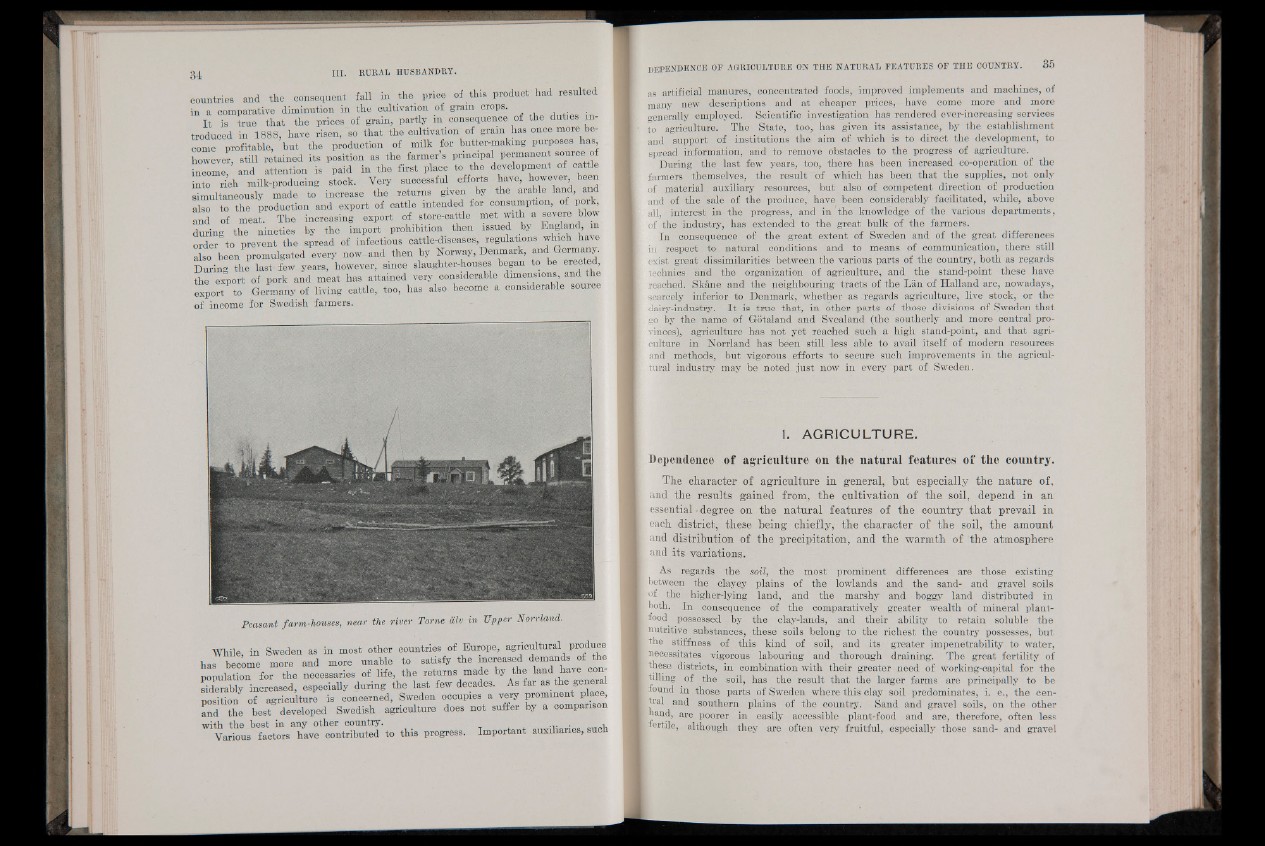
countries and the consequent fall in the price of this product had resulted
in a comparative diminution in the cultivation of gram crops. .
It is true that the prices of grain, partly m consequence of the duties introduced
in 1888, have risen, so that the cultivation of gram has once more be-
come profitable, but the production of milk for butter-making purposes has,
however, still retained its position as the farmer’s prinmpal permanent source of
income, and attention is paid in the first place to the development of cattle
into rich milk-producing stock. Very successful efforts have, however been
simultaneously made to increase the returns given by the arable land, and
also to the production and export of cattle intended for consumption, of pork,
and of meat. The increasing export of store-cattle met with a severe blow
during the nineties by the import prohibition then issued by ¡Fnglgffig m
order to prevent the spread of infectious cattle-diseases, regulations which have
also been promulgated every now and then by Norway, Denmark, and Germany.
During the last few years, however, since slaughter-houses began to be erected,
the export of pork and meat has attained very considerable dimensions and the
export to Germany of living cattle, too, has also become a considerable source
of income for Swedish farmers.
Peasant farm-houses, near the river Tome .alv in Upper Norrland.
While, in Sweden as in most other countries of Europe, agricultural produce
has become more and more unable to satisfy the increased demands of the
population for the necessaries of life, the returns made by the land have considerably
increased, especially during the last few decades. As far as g é n é r a l
position of agriculture is concerned, Sweden occupies a very prominent place,
and the best developed Swedish agriculture does not suffer by a compariso
with the best in any other country. K H .
Various factors have contributed to this progress. Important auxiliaries, such
as artificial manures, concentrated foods, improved implements and machines, of
many new descriptions and at cheaper prices, have come more and more
generally employed. Scientific investigation has rendered ever-increasing services
to agriculture. The State, -too, has given its assistance, by the establishment
and support of institutions the aim of which is to direct the development, to
spread information, and to remove obstacles to the progress of agriculture.
During the last few years, too, there has been increased co-operation of the
farmers themselves, the result 'of . which has been that the supplies, not only
of material. auxiliary resources, but also of competent direction of production
and of the sale of the produce, have been considerably facilitated, while, above
all, interest in the progress, and in the knowledge of the various departments,
of the industry, has extended to the great bulk of the farmers.
In consequence of the great extent of Sweden and of the great differences
in respect to natural conditions and to means of communication, there still
exist great dissimilarities between the various parts of the country, both as regards
technics and the organization of agriculture, and the stand-point these have
reached. Skâne and the neighbouring tracts of the Lan of Halland are, nowadays,
scarcely inferior to Denmark, whether as regards agriculture, live stock, or the
dairy-industry. It is true that, in other parts of those divisions of Sweden that
go by the name of Gotaland and Svealand (the southerly and more central provinces),
agriculture has not yet reached such a high stand-point, and that agriculture
in Norrland has-been still less able to avail itself of modern resources
and method s,:;'"hut vigorous efforts to secure such improvements in the agricultural
industry may be noted just now in every part of Sweden.
1. AGRICULTURE.
Dependence of agriculture on the natural features of the country.
The character o f agriculture in general, but, e sp e c ia lly th e nature of,
and the results gained from, th e cu ltiv a tion o f th e so il, depend in an
essential • d egree on th e natural featu res o f th e country th a t pr ev a il in
each district, these be in g c h ie fly , th e character o f the soil, th e amount
and distribution o f the precipitation, and th e warmth o f th e atmosphere
and its variations.
As regards the soil, the most prominent differences are those existing
[ between the clayey plains of the lowlands and the sand- and gravel soils
; oi the higher-lying land, and the marshy and boggy land distributed in
’ both. In consequence of the comparatively greater wealth of mineral plant-
; food possessed by the clay-lands, and their ability to retain soluble the
nutritive substances, these soils belong to the richest the country possesses, but
[ the stiffness of this kind of soil, and its greater impenetrability to water,
: necessitates vigorous labouring and thorough draining. The great fertility of
t these districts, in combination with their greater need of working-capital for the
tilling of the soil, has the result that the larger farms are principally to be
I found in those parts of Sweden where this clay soil predominates, i. e., the central
and southern plains of the country. Sand and gravel soils, on the other
; nand, are poorer in easily accessible plant-food and are, therefore, often less
I ertile, althpugh they are often very fruitful, especially those sand- and gravel